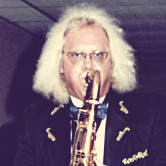
I promise that this explanation of the physics of saxophone playing will be totally devoid of higher math, complex formulas, or scientific jargon. I further hope that your eyes will not glaze over, and that you will leave this article with a clear understanding of the physics of saxophone sound production and how these laws affect your playing. My goal here is to provide a clear and simple explanation of the key concepts. To attain this goal, I’ll use some generalized ideas and approximations. I don’t intend to delve into the realm of super scientific and precise explanation. This presentation is intended to provide you with basic concepts you can use to understand and improve your playing, and is not in any way to be construed as a scholarly work. I sincerely believe that if you understand the basics of the science that goes on inside your saxophone, you will be able to deal more effectively with your instrument, and that, of course, will make you a better player.
IT ALL STARTS WITH THE REED
The basic idea is really quite simple, the player raises the air pressure on the reed by blowing, which acts as an energy source that generates a continuous stream of vibrations to the instrument. The length and shape of the bore of the instrument determine the pitch and basic tone color. There’s really not a lot more to it than that, but the details can be quite maddening.
The reed is flexible, and responds to increases in air pressure from the player’s body. If the pressure provided by the player is too low, the air flows through the gap between the reed and the top of the mouthpiece. When the pressure is increased to the correct amount, the reed closes against the tip of the mouth- piece. If the pressure is too great, the reed stays closed against the mouthpiece.
As the wave travels down the length of the bore, the friction caused by contact with the bore results in a decrease in pressure which allows the reed to release from its closed position. Since the flow of air provided by the player is continuous, the cycle repeats. Changes in the amount of pressure on the reed can significantly affect the pitch and characteristics of the tone produced by the reed. As increasing air pressure is applied, the fundamental tone gains more and more harmonics, and loses mellowness. As more pressures are applied, the wave form produced changes from curved to square, and contains even more upper harmonics. These square wave forms are considered to be inappropriate for legitimate playing by many saxophonists, but are often favored by rock ‘n roll players. For this reason, a harder reed tends to maintain a mellow tone at higher volume levels. The addition of harmonics to the fundamental also gives the impression of increased loudness, because the human ear is sensitive to those harmonics.
Soft reeds are more flexible than hard reeds, and thus are more responsive to changes in pressure inside the mouthpiece. They push out from the facing when the pressure inside the mouthpiece increases.Conversely, they close more easily when the pressure is diminished. As a result of this pressure fluctuation, the frequency is reduced, with the effect being greater for high pitches than for lower ones. For this reason soft reeds tend to play flatter in pitch.
THE CONICAL CLOSED PIPE BORE
The saxophone bore is basically a cone, open at one end (the bell), and closed at the other. The closed mouthpiece end doesn’t come to a point, as in a true cone. That missing portion can be calculated, and the volume of the tone chamber of the mouthpiece should equal the volume of the missing portion. If there is a variation in the two volumes, intonation difficulties can be the result. This is why some mouthpieces just don’t work on some horns. The internal dimensions are too small to correctly complete the missing portion of the cone.
As the sound waves generated by the mouthpiece and reed travel down the horn toward the bell, the amplitude of the wave gets progressively smaller as the waves spread out. Upon reaching the end of the bell the waves enter an area of normal atmospheric pressure.
The further down the conical bore the waves travel, the lower the pressure. As the waves travel, they form secondary waves,known as harmonics. The sequence of these waves is predictable, and is as shown in Example 1.

Example 1
The note sequence in Example 1 is familiar to anyone who has studied the altissimo range of the saxophone. All of the pitches can be produced by fingering low Bb and altering the air stream pressure from the player’s body. Of course, the pitches deviate somewhat as they increase in frequency, with the upper pitches tending to become sharper. The mix of these harmonics, together with the fundamental frequency, deter- mines the tonal spectrum of the saxophone. As air pressure from the player increases, the harmonics become more prominent.
The embouchure serves to dampen the frequency of the reed, so the natural resonances of the bore begin to dominate the waves, which will always be of a lower frequency than the vibrational frequency of the reed itself.
Of course, most members of the saxophone family are curvedin shape, and allowance must always be made for the flow of the wave through this curvature. Realistically, the curved saxophones are built around four cones of different tapers, the neck, the body tube, the bow, and the bell. Some straight soprano saxophones have a noticeable “step” in the upper part of the bore to improve the intonation match between octaves. The true reason behind the curve is playing comfort and the limits of the players reach. A well designed curved saxophone should be indistinguishable in sound and playing characteristics from a straight one.It is also essential (and often overlooked by designers) to consider the fact that the tone hole chimney adds volume to the cone, and that the diameter of the bore is effectively increased at the point of each tone hole.
HOW THE REGISTER HOLES WORK
Most saxophones have two register holes, activated by the octave key. In a perfect world our saxophones would have twelve register holes, one for each semi-tone of the chromatic scale. However, this would be a mechanical nightmare, and although not a perfect compromise, the system of two vents found on most saxophones functions in an acceptable manner. The small register hole destroys enough pressure from the fundamental wave to enable the second harmonic (one octave higher than the fundamental) to become dominant. This miracle of science enables saxophonists to use the same fingerings for both octaves of the saxophones range. Much experimentation has been done with this aspect of saxophone design, and today saxophones with multiple register holes and specialized keys for the altissimo range are offered.
TONE HOLES AND PITCH
To raise the pitch of our saxophone we must make the conical tube shorter. Starting from the end of the bell, each open tone hole raises the pitch one semi-tone. The opening of each successive tone hole shortens the overall length of the conical tube by about 6%. The diameter of each tone hole is roughly correlated with the tube diameter at that point, with adjustments in size often necessary to facilitate temperament of the scale. The opening of the tone hole causes the wave to lose pressure as it moves down the bore, thus shortening its length and raising the pitch. It’s not an altogether perfect system because the waves have a tendency to exert pressure beyond the first open tone hole they encounter. The higher pitches exert more pressure than the lower ones, and this effect is more significant in the upper registers.
These factors are the most difficult obstacles to building a saxophone with perfect intonation, and the failure to properly understand them has been the downfall of many a saxophone designer. Matching the intonation between octaves is universally agreed to be the most difficult part of saxophone design. A very special problem area is the use of cross fingerings, such as C2/C3 and F#1/F#2. Here, another tone hole is closed “downstream” from the first open tone hole, and this effectively lengthens the tube. This effect is heightened in the higher pitches as the tone holes become smaller and the wave frequencies increase. Of course, the situation is even worse in the second register, where wave frequencies are even higher.
The wave has a certain amount of momentum and tends to travel beyond its intended point of escape. A careful designer must always be mindful of this phenomenon. Over the years, various solutions have been tried to overcome this problem,including the “double G” keys on the early Kings; the bow mounted speaker key on the Holton “Rudy Weidoft Model;” and the upper stack speaker key used on the later LA Sax horns.
HOW THE BELL AFFECTS SOUND
The bell of the saxophone serves to radiate the waves out into standing air. The more the waves are radiated out, the less the waves are reflected inside the bore, and the instrument projects more. The bell shape may also be selective in that it favors certain frequencies over others, resulting in improved response at certain points in the range. A properly designed bell can significantly aid in the production of the lowest tones. A good design will ease the production of the lower tones by reducing resistance in the final portion of the bore.
Care must be taken that the bell design does not adversely affect note (particularly cross fingered ones) in the extreme upper register. Some of the big bells offered today give good low note response at the expense of the upper end of the horn, so bigger is not always better. The larger bells often used have less effect on the upper pitches due to the intervention of open tone holes before the bell opening. In the absence of a bell, or if the bell is too small, the instrument will be very dull in sound and lack projection.
SUMMARY
There aren’t a lot of simple black and white solutions to good saxophone design. The factors which must be considered in designing an instrument which plays well in tune and is responsive in all registers are many. A solution for a problem in one place on the horn may very well result in a problem in another area. Good results are totally dependent on a complete understanding of the physics and mathematics involved, and the willingness of the designer to pursue seemingly endless experimentation in the quest for the optimum solution. Because many of the solutions are by definition compromises, multiple prototypes are generally produced before the design is finalized for production and sale to end users.
This article was intended to be the most basic of introductions to the topic. I am happy to answer any questions and love discussing this subject. You may contact me via email at [email protected].


